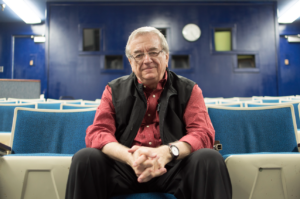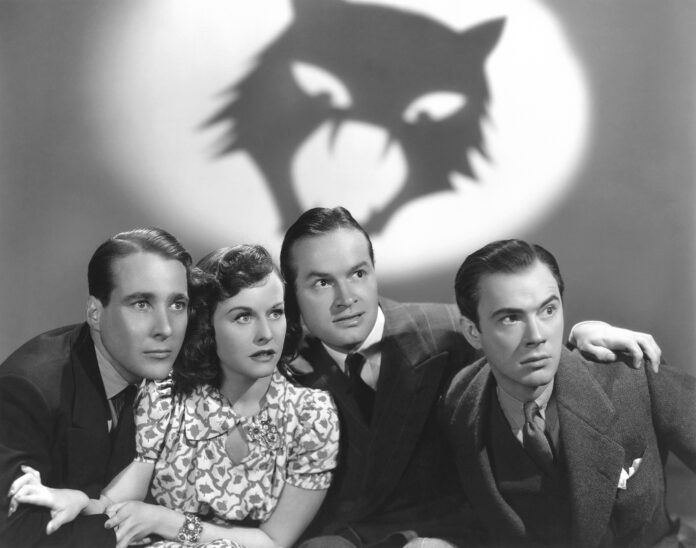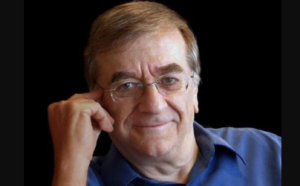“The Best Movies You’ve Never Heard Of” is a series of articles devoted to little-known movies of exceptional quality that dedicated film buffs may be aware of but have somehow fallen through the cracks of the general public’s awareness.
Betcha didn’t know that Bob Hope was in a horror movie, did you? And unlike its companion piece The Ghost Breakers, which was a comedy with horror content, The Cat and the Canary was a serious horror picture with Hope playing the comedy relief. Yes, it was made before Hope was a big enough name to be able to pick and choose which films he would make, but he was glad to do the picture because it was a major step up that convinced the Paramount suits that he had the makings of a star. In fact, Paramount’s decision to make The Cat and the Canary happened only because Universal Pictures defiantly ignored the demands of the Hays Office, the censors charged with enforcing the Production Code. But, first, a little backstory…
One of the main goals of the 1934 Production Code was to eliminate two popular genres the professional scolds found particularly objectionable: horror movies and gangster pictures. To the bluenoses, both genres lacked any redeeming values because they “glorified” protagonists who specialized in killing people. Leave it to Warner Brothers, the studio that didn’t invent the gangster genre but was responsible for making it box office gold, for finding a way to do an end run around the Hays Office by making pictures where former gangster stars like James Cagney and Edward G. Robinson played officers of the law who fought the mob in pictures like “G” Men and Bullets or Ballots. (The joke was that these more “respectable” gangster pictures were far more violent than their earlier counterparts. Seems the censors didn’t mind the bad guys being blown away graphically.)
A few horror pictures got past the Hays Office, such as Universal’s Bride of Frankenstein (1935), which had been in the pipeline too long (under the title The Return of Frankenstein) to be canceled. But Universal’s plans for an elaborate sequel to Dracula (1931) were revised, and the resulting film Dracula’s Daughter (1936) was done on a much smaller scale than originally planned. (Although it was still a first-rate atmospheric little horror tale.) Warner Brothers’ The Walking Dead (1936) was a rare case of a horror film benefiting from the Code’s restraints, resulting in a much more subtle and haunting mood piece than had been previously planned and featuring one of Boris Karloff’s finest performances.
In the two-year period of 1937-38, however, Hollywood made no horror pictures whatsoever. (Unless you count Warner Brothers’ 1937 comedy mystery Sh! The Octopus is a horror picture.) As film historian William K. Everson pointed out in his 1986 book More Classics of the Horror Film, the censors in the UK, one of Hollywood’s most profitable foreign markets, were also demanding a crackdown on American horror movies, yet another inducement to curtail the genre. The ban on horror films might’ve lasted even longer but for the fact that, in 1938, Universal Pictures was on the verge of bankruptcy. They desperately needed a surefire hit in order to stay in business, and seeing as the two biggest box office successes in their history were Frankenstein and Bride of Frankenstein, it was a no-brainer to make a third Frankenstein picture, the Hays Office and British censors be damned. Released in mid-January 1939, Son of Frankenstein proved to be (pardon the expression) a monster hit. Predictably, all of the Hollywood studios started scrambling to cash in on the horror “revival.”
This brings us back to Paramount Pictures, who’d had Bob Hope under contract since 1937. Why they signed Hope isn’t clear because the Paramount suits didn’t have much faith in Hope’s box office potential. To them, he was just a second-string version of a radio comedian they already had under contract, Jack Benny. In fact, Benny turning down a role in the all-star musical extravaganza The Big Broadcast of 1938 led to Hope being cast in his first Paramount film. Despite Hope and Shirley Ross’ rendition of the Leo Robin-Ralph Rainger number “Thanks for the Memory” (soon to become Hope’s theme song) getting the best reviews in the picture, the front office still didn’t see a future for Hope. They demoted Hope to producer Harold Hurvey’s low-budget unit at Paramount (“Hurley’s B-hive,” Hope called it), where he made two more pictures with Ross and three pictures where he played second-banana to Martha Raye, who was the one the suits were convinced would be the next big comedy star. The only reason the studio didn’t drop Hope’s option altogether was his increasing popularity on the radio.
When Son of Frankenstein revived the horror genre, Paramount decided to produce a new remake of John Willard’s 1922 stage thriller The Cat and the Canary, which had been filmed twice before, first as a visually stylish and highly-acclaimed 1927 silent picture directed by German emigrate Paul Leni and then as a 1930 early talkie (retitled The Cat Creeps) which was less well-received.(Universal Pictures produced both of these versions.) The play’s hero is a comic coward named Paul Jones, a “horse doctor” who’d had a crush on the story’s damsel in distress since childhood. Even though he’s scared stiff of the mysterious going-on in the play’s creepy old mansion setting, he appoints himself her protector. (Unlikely as it seems, Henry Hull, perhaps best remembered for his dramatic performance in Alfred Hitchcock’s Lifeboat, played the role in the Broadway premiere.) In Leni’s silent version, the character was played by Creighton Hale, but as Everson put it, “Leni was hardly a comedy director, nor was Hale much of a comedian.”
Someone at Paramount, probably producer Arthur Hornblow Jr., had the inspiration of casting Hope in the film’s equivalent of the Paul Jones role. Renamed Wally Campbell (coincidentally Paul Jones was also the name of a Paramount producer who worked on several of Hope’s pictures), the character became a radio actor who’s done his share of mystery plays on the air. Thus, anticipating Scream and The Cabin in the Woods, Wally is well aware of the clichés of the mystery and horror genres and is able to anticipate or comment on the tropes as they unfold in the film’s course. Hope remained grateful for the opportunity for the rest of his life and referred to The Cat and the Canary as “the turning point for my movie career.” Significantly, although he was given top billing, Hope’s name doesn’t appear in the credits until after the title, making it clear that this was an ensemble effort, not a starring vehicle for Hope. Although he had ample opportunities to take center stage, the entire picture doesn’t completely revolve around his character. (Richard Zoglin, author of last year’s biography Hope: Entertainer of the Century, described The Cat and the Canary as having “a mise-en-scene and narrative coherence that sets it apart from any of Hope’s previous films.”)
The direction was assigned to writer, director, and sometimes actor Elliott Nugent and the screenplay to Walter DeLeon and Lynn Starling. (Nugent’s most notable credit was starring in and co-writing with celebrated humorist James Thurber the 1940 play The Male Animal, a satire on red-baiting in American academia.) Nugent had previously directed Hope in two of the pictures he did with Martha Raye, Give Me a Sailor (1938) and Never Say Die (1939), and would go on to direct two more Hope vehicles Nothing But the Truth (1941) and My Favorite Blonde (1947). Nugent was a good, if not terribly inspired director, so undoubtedly, the credit for the movie’s considerable visual creativity belongs far more to Charles Lang’s chiaroscuro black and white cinematography (with some uncredited assistance from Ted Tetzlaff) and the atmospheric sets by Hans Dreier (Paramount’s foremost art director) and Robert Usher. (Some of the sets, like the exterior and grounds of the decrepit old estate and the dark foreboding labyrinth that runs through and under the house, were obviously influenced by the German Expressionist silent films of the 1920s.) Dr. Ernst Toch’s haunting music score, with its ghostly chorus in key scenes, also contributed to the movie’s spooky feel.
After the main credits (which are superimposed over a pair of shutters eerily opening and closing in the wind), we are given our first glimpse of the movie’s gloomy setting with the following introduction text:
“… not far from New Orleans there still exist in strange solitude the bayous of Louisiana…”
(The play was set in a remote area of upstate New York.) In separate parties, guests are being transported via either canoe or motorboat to an old, dark, dilapidated mansion isolated on an island in the swamp that once belonged to the late Cyrus Normand. The deserted estate has been entrusted to the care of a mysterious Creole housekeeper named Miss Lu (Gale Sondergaard, who would soon be typed in mysteries and horror films). (In the play, the housekeeper was Mammy Pleasant, described by Willard as an “old negress.”) The midnight reading of Normand’s will ten years after his demise is the occasion.
The first to arrive is Normand’s lawyer and executor Mr. Crosby (George Zucco, who would also become a mainstay in horror pictures). After he extracts the will from the wall safe, Crosby notices that the envelope has obviously been opened and resealed, indicating that one of the potential heirs has already seen the contents of the will, the first indication that foul play is in the works. The next group to arrive include Aunt Susan (Elizabeth Patterson, who’d played the same role in The Cat Creeps), a caustic shrewish spinster; Aunt Cicily (Nydia Westman), a rather flighty, scatterbrained type; Charlie Wilder (Douglass Montgomery), a charismatic scoundrel who’s the “black sheep” of the family; and Fred Blythe (John Beal), a sour, sullen young cynic who’s the antithesis of Charlie’s carefree playboy. Finally, about eight minutes into the movie, as the film cuts back to the swamp, Wally appears in a canoe rowed by an Indian native (Chief Thundercloud). Wally tries to converse with his guide but to no avail. Then he tosses the cigar he’s smoking out of the canoe, only to do a double-take when an alligator snatches up the stogie in its jaws. He again attempts to lighten the mood.
Wally: (nervously) “You seem like the jolly type, Clarence. Do you like jokes?” (no answer) “You don’t mind if I ramble on, do you? It keeps my mind off the malaria germs.” (gulps) “Anyway, here’s one. A farmer had a cow. He couldn’t afford to feed it alfalfa, so he fed it sawdust. He saved a lot of money all right, but he sure wasted a lot of time getting the splinters out of the milk!” (laughs) “Doesn’t that just—“ (no response) “—uh, splinters, milk, don’t you get it?”
Indian: (deadpan, taciturn) “Heard it last year. Jack Benny program.”
After reaching the mansion and going through the introductions to the others, Wally looks around.
Wally: “Well, where’s the leading lady?”
Crosby: “Leading lady?”
Susan: “Young man, did you inherit the streak of insanity that’s runs through this family?”
Fred: (sourly) “What was that ‘leading lady’ crack?”
Wally: “Oh, nothing really, but all this, midnight, the alligators—I mean, the heirs—and the family lawyer all gathered to hear the reading of the will. It reminds me of a lot of melodramas and mysteries I’ve played in.”
Cicily: (giggles nervously)
Wally: “Uh… thanks. And in every one of those plays there was a leading lady, young, beautiful… a modern, charming—“
Joyce: (off-stage) “Thanks. Will you take this for me please?”
Right on cue, Joyce Normand (Paulette Goddard, looking most fetching) makes her entrance. (“Well, I got here. Oh, I’m terribly sorry to be so late.”) The party now complete and the stroke of midnight chiming on a grandfather clock, the reading of the will commences. As Crosby takes the document out of its envelope, a mysterious gong sounds seven times. Eyes closed and hands folded as in prayer, Miss Lu begs her “master” to tell her “the name.” Questioned by Crosby what those sounds mean, she explains, “They mean seven will live. There are eight people in this room. One will die before morning.” As Crosby tries to resume reading the will, Wally snaps his fingers and says to Charlie, “I’ll bet you two to one Joyce is the heir.”
Crosby: “What’s that?”
Wally: “Oh, did I speak out of turn?”
Crosby: “What was back of your remark?”
Wally: “Oh, nothing.”
Fred: (accusingly) “Come on, you meant something!”
Wally: “Oh, nothing, really. Well, it’s just that in practically every mystery play I’ve been in the leading lady turns out to be the heir.”
Miss Lu: (reverently) “You have the power.”
Wally: “Yeah, uh… me?!”
Miss Lu: “There’s spirits all around you.”
Wally: (nervously) “Well, could you put some in a glass with a little ice? I need it badly.”
Fred: (threateningly) “Don’t you ever stop babbling?!”

As indicated by the dialogue exchanges quoted above, Hope had already started what would become a career-long habit of letting his personal gag writers see his movie scripts in advance to provide him with additional one-liners. The two most memorable (and oft-quoted) of these lines find Cicily playing straight man to Wally.
Cicily: “Don’t big empty houses scare you?”
Wally: “Not me. I used to be in Vaudeville.”
And later in the film when Wally and Cicily explore the house’s basement:
Cicily “It’s awfully spooky down here. Do you believe in reincarnation?”
Wally: “Huh?”
Cicily “You know, that dead people come back?”
Wally: “You mean like the Republicans?”
And then there’s Wally’s line that would be stolen by just about every comedian in Hollywood: “I’m so scared even my goose pimples have goose pimples.”

As it turns out, once the will is finally read, Wally’s prediction is accurate; Joyce is indeed the sole heir to Cyrus’ fortune and estate. But there’s an addendum: if the heir should die or be proven to be insane within one month of the will being read, an alternate heir named in a second will receives the inheritance. Fred is particularly outraged and rightly points out that the will “is practically an invitation to commit murder!” Miss Lu also presents Joyce with a letter that proves to be a clue to the story’s second MacGuffin, a priceless diamond necklace secreted somewhere on the estate. And there’s one more joker in the deck: an armed guard named Hendricks (John Wray) from an asylum for the criminally insane is prowling the island in search of an escaped homicidal maniac known as “The Cat.”

At this point, sinister events begin happening within the house. Crosby is seized and kidnapped by a grotesque hand that emerges from a hidden panel in the library. Wally and Joyce figure out where the necklace is hidden, but while Joyce lies in bed, the same hand reaches out from a panel above her and takes the necklace, leaving her in hysterics. When Wally tries to find the tripwire that opens the panel, yet another secret panel opens, and the body of the first murder victim tumbles out from it. (Leni filmed this moment in the silent version from a low angle so that the corpse fell toward the camera. In addition to becoming one of the movies’ most oft-repeated clichés, it also became obligatory to use this low angle for the exact same scene in all the subsequent film versions of The Cat and the Canary.) And then there’s another particularly frightening moment in the library when Joyce thinks she’s alone, but I’m not about to spoil that one. (The moment in question was taken directly from the stage version.)

It’s in the last ten of the movie’s brief 75-minute running time that the terror quotient gets kicked up to full blast. Wally makes his way into the house’s series of hidden corridors through the panel in the bedroom. Joyce, once again seemingly alone in the library, sees the panel that Crosby disappeared into the opening. She walks up to the entrance as Wally calls her from the bedroom. Thinking that Wally’s voice is coming from inside the hidden passage, she enters and is locked in by the killer. A chase begins through a series of dark underground tunnels with the maniac in close pursuit of Joyce. Yet two more people will be violently killed before the film’s end. (You’ll have to watch the movie for yourself to learn the outcome, including the final reveal of the story’s villain.)
Released in early November of 1939, The Cat and the Canary was a resounding success at the box office. Hope’s stardom was cemented in his next film when he co-starred with Bing Crosby and Dorothy Lamour in the first entry of what would become Hollywood’s most successful film franchise to date, Road to Singapore (1940). The popularity of The Cat and the Canary made a follow-up effort with Hope and Goddard a foregone conclusion. Paramount dusted off another old stage thriller, Paul Dickey and Charles W. Goddard’s The Ghost Breaker (1914), and retitled it The Ghost Breakers. This time Hope got first-billing above the title for the first time in his film career, indicating that this was a star vehicle designed especially for Hope. The Ghost Breakers was more of an out-and-out comedy than a horror picture, with comedian Willie Best added to the mix as Hope’s houseboy.Although it had some spooky moments to rival the best of serious horror movies, The Ghost Breakers fell short of the overall quality of The Cat and the Canary. It didn’t help that the film was clumsily constructed and that the characters didn’t arrive at the story’s haunted Cuban castle setting until the movie was two-thirds over. Also, frankly, the director George Marshall was a pedestrian filmmaker. (Acclaimed mystery author Raymond Chandler, whose original screenplay The Blue Dahlia was filmed by Marshall, described the director as “a stale old hack who had been directing for thirty years without once having achieved any real distinction.”)
In 1978, The Cat and the Canary was filmed for a fourth (and, so far, last) time in Britain, with Americans Michael Callan and Carol Lynley in the leading roles. Director Radley Metzger (who got his start in softcore porno films) added some kinky touches to the story, but, despite a stellar cast (including Edward Fox, Wendy Hiller, and Wilfred Hyde-White), this remake had absolutely none of the haunting atmosphere of the 1927 and 1939 versions.
For decades, the 1939 version of The Cat and the Canary was unavailable because it was one of the films excluded from the Paramount Library when it was purchased by MCA (Universal Pictures’ parent company) in the 1950s because it was tied up in copyright conflicts. W.C. Fields’ You’re Telling Me (1934) and the Marx Brothers’ Animal Crackers (1930) were also among the films stuck in this copyright limbo. You’re Telling Me was bailed out by Universal in the early 70s after William K. Everson made a big deal out of its unavailability in his 1967 book The Art of W.C. Fields. It wasn’t until 1974, when UCLA student (and future television writer) Steve Stoliar collected several thousand signatures on a petition, that the Universal suits finally gave in to settling the pending copyright issues and rereleased Animal Crackers to the theaters. Amazingly, it wasn’t until 2010, over 70 years after its release, that Universal finally made The Cat and the Canary available to the public on DVD. At least now, it can be appreciated as an excellent thriller and a real treat for Bob Hope fans.
Similarly: The Best Movies You’ve Never Heard Of: “Funny Bones” (1995)




